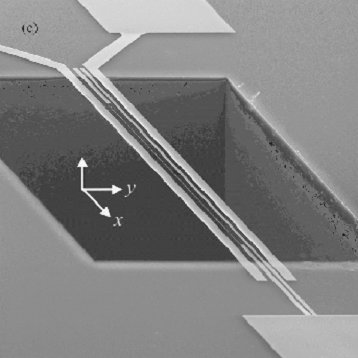| Introduction |
| Casimir's Biography |
| Measurements |
| Zero Point Energy |
| Calculations |
| Fundamental Physics Links |
| ESA Programme |
| MEMS and NEMS |
 Although Casimir proposed his effect in 1948 it was not until 1997 that S. K. Lamoreaux measured
the force using a torsion balance (Phys Rev Lett 78 Jan 1997
"Demonstration of the Casimir Force in the 0.6 to 6 mm Range" ) which was confirmed the
following year by U Mohideen and Anushree Roy, using an atomic force microscope. ( Phys. Rev. Lett. 81,
4549 (1998)
Although Casimir proposed his effect in 1948 it was not until 1997 that S. K. Lamoreaux measured
the force using a torsion balance (Phys Rev Lett 78 Jan 1997
"Demonstration of the Casimir Force in the 0.6 to 6 mm Range" ) which was confirmed the
following year by U Mohideen and Anushree Roy, using an atomic force microscope. ( Phys. Rev. Lett. 81,
4549 (1998)
Picture from Scientific American & S. K. Lamoreaux, Phys. Rev. Lett. 78, 5 (1997)
In Lamoreaux's experiment a gold coated spherical lens face is brought close to a flat plate by means of a piezo stack. The flat plat is mounted on one arm of the torsion balance. The other arm of the torsion balance formed the central electrode of a pair of parallel plate capacitors. By applying voltages to the capacitors the the restoring force required to compensate for any torque in the torsion balance could be measured, as a measure of the Casimir force.

In Mohideen and Roy's experiment the force between an aluminium coated polystyrene sphere and an opticaly polished flat saphire disk (also aluminium coated) is measured by the deflection of a laser beam. The laser beam is reflected from the cantilever on which the sphere is mounted, and the position of the reflected beam determined by the output of a pair of photodiodes. A piezo stack is used to bring the flat disk close to the sphere.

Chan and co-workers at Bell Labs Lucient Technologies demonstrated the first interaction of the Casimir force with a MEMS device in 2001. By bringing a gold coated sphere of 100mm diameter close to a MEMS seesaw paddle consisting of 3.5mm thick heavily doped polysilicon plate of 500mm2 suspended 2mm above a substrate, on thin torsion rods, they were able to rock the plate when the sphere came to within a few 100nm.
Detrimental effects of the Casimir force such as stiction in MEMS devices was suggested by Serry et al in 1998 and was in fact seen in Chan’s experiments as the paddle became attached to the substrate beneath it.
 The stiction adhesion energy of fine gold beams 200mm long and 250 x 240 nm cross
section was quantified by Buks and Roukes in 2001.
The stiction adhesion energy of fine gold beams 200mm long and 250 x 240 nm cross
section was quantified by Buks and Roukes in 2001.
F. Chen, U. Mohideen, and others have recently (2001) measured the lateral Casimir force between a sinusoidally corrugated gold coated plate and large sphere at surface separations between 0.2 µm to 0.3µm using an atomic force microscope.
There is no longer any doubt about the reality of the Casimir force and its potentially harmful influence on MEMS. However, one of the more important consequences is the potential that the Casimir effect offers to provide a cure for stiction owing to the possibility of generating a repulsive force by appropriate choice of material or geometry.

